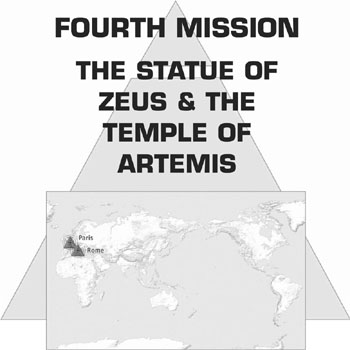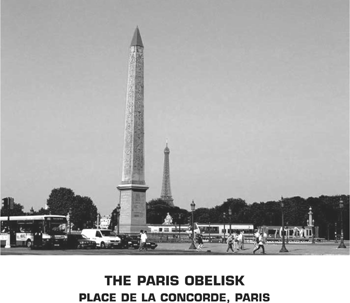Seven Ancient Wonders (30 page)
Read Seven Ancient Wonders Online
Authors: Matthew Reilly

‘The Hanging Gardens of Babylon couldn’t be exactly replicated, since no-one knows what they looked like, so a special rambling garden was built and tended in their honour at the White House,
first by George Washington, then Thomas Jefferson and later, Franklin Roosevelt. The Catholic president, John F. Kennedy, tried to rip the garden up, but he never managed it entirely. And while he didn’t survive, the garden did. It’s had many names over the years, but we now call it the Rose Garden.’
Big Ears folded his arms. ‘What about the Great Pyramid, then? I don’t know of any monumental pyramids in the US.’
‘That’s true,’ West said, ‘there are no giant pyramids in America. But when the Egyptians stopped building pyramids, do you know what they started building instead?’
‘What?’
‘Obelisks. The obelisk became the ultimate symbol of Sun-worship. And America does indeed possess one colossal obelisk: the Washington Monument. Interestingly, it is 555 feet tall. The Great Pyramid is 469 feet tall, 86 feet shorter. But when you take into account the height of the Giza Plateau at the point where the Great Pyramid stands—86 feet—you will discover that the peaks of both structures sit at
the exact same height
above sea-level.’
While this conversation was going on, Wizard was gazing at the text in the notebook.
‘The only temple that bears both their names. . . ’ he mused. Then his eyes lit up. ‘It’s Luxor. The Temple at Luxor.’
‘Oh, yes. Good
thinking
, Max. Good thinking!’ Zoe clapped him on the shoulder.
‘It would certainly fit. . . ’ West said.
‘What would fit?’ Big Ears asked, again not understanding this code they were using.
‘The Temple of Amun at Luxor in southern Egypt, more commonly known as the Temple at Luxor,’ Zoe said. ‘It’s one of the biggest tourist attractions in Egypt. The famous one with the giant pylon gateway, the two colossal seated statues of Rameses II, and the lone obelisk out the front. It stands on the east bank of the Nile in Luxor, or—as it used to be called—Thebes.
‘The Luxor Temple was built by several older pharaohs, but Rameses II comprehensively rebuilt it and so claimed it as his own. It was also augmented, however, by none other than Alexander the Great. Which is why—’
‘—it’s the only temple in all of Egypt in which Alexander the Great is recorded
as a pharaoh
,’ Wizard said. ‘At Luxor alone, Alexander’s name is carved in hieroglyphics and enclosed in a ringlike cartouche.
The only temple that bears both their names
: the Luxor Temple is indeed the only temple that bears both the names of Rameses II and Alexander.’
Big Ears said, ‘So what about threading
the power of Ra through the eyes of Great Rameses’s towering needles
?’
West said, ‘Towering needles are usually obelisks. The power of Ra, I’m guessing, is sunlight. Dawn sunlight on Judgement Day: the day of the Tartarus Rotation. This verse is telling us that on the day of the Rotation, the morning Sun will shine through two matching holes in the obelisks to reveal the location of the tomb.’
Big Ears turned to Zoe. ‘But I thought you said there’s only one obelisk still standing at Luxor.’
Zoe nodded. ‘That’s right.’
‘So we’re screwed. Without the two obelisks, we can’t see how the Sun shines through them, so we’ll never be able to find Alexander’s Tomb.’
‘Not exactly,’ Wizard said, his eyes gleaming at West and Zoe.
They both smiled back at him.
Only Big Ears didn’t get it.
‘What?
What?
’
Wizard said, ‘The second obelisk from the Temple at Luxor still exists, Big Ears, just not in its original location.’
‘So where is it?’
Wizard answered him. ‘Like many of the obelisks of ancient Egypt, it was given to a Western nation. Thirteen obelisks went to Rome, taken by the Sun-worshipping Catholic Church. Two went to London and New York—the pair of obelisks known as Cleopatra’s Needles. The second obelisk from the Temple of Luxor,
however, was given to the French in 1836. It now stands in pride of place in the Place de la Concorde, in the very heart of Paris, about 800 metres from the Louvre.’
‘The Zeus Piece
and
the obelisk,’ Zoe said. ‘Looks like it’s going to be double-trouble in Paris.’
West leaned back in his seat.
‘Paris,’ he said, ‘isn’t going to know what’s hit her.’

PARIS–ROME
18 MARCH, 2006
2 DAYS BEFORE TARTARUS

 | THE CHAMPS-ÉLYSÉES PARIS, FRANCE 18 MARCH, 2006, 11:00 A.M. 2 DAYS BEFORE THE ARRIVAL OF TARTARUS |
Jack West Jr sped around the huge multi-laned roundabout that encircled the Arc de Triomphe, whipping through traffic in a rented four-wheel drive SUV.
Lily sat in the passenger seat, while in the back were Pooh Bear, Stretch and Big Ears.
They all sat in tense silence, as one does before an outrageously daring mission deep inside enemy territory.
The heart of Paris is shaped like a Christian cross.
The longer beam of this giant cross is the Champs-Élysées, which travels all the way from the Arc de Triomphe to the Palais du Louvre. The short horizontal transept of the cross ends with the National Assembly at one end and the stunning Church of St Mary Magdalene at the other.
Most important of all is what lies at the junction of these two axes.
There one will find the Place de la Concorde.
Made famous in the French Revolution as the venue for the executions of hundreds of noblemen and women, the Place de la Concorde was the bloody home of the guillotine.
Now, however, in the exact centre of this plaza, in the exact
centre of Paris—the very
focal point
of Paris—stands a towering Egyptian obelisk.
The second obelisk from the Temple of Luxor.
Of all the obelisks in the world—whether still in Egypt or not—the Paris Obelisk is unique in one important respect:
The pyramidion at its peak is coated in gold.
Historians love this, because this was how obelisks appeared in ancient Egyptian times: the tiny pyramids on their peaks were coated with electrum, a rare alloy of silver and gold.
Interestingly, however, the golden pyramidion on the Paris Obelisk is only a very recent addition—it was added to the great stone needle in 1998.
‘Pooh,’ West said as he drove, ‘you checked the catacombs?’
‘I did. They’re clear. The entry gate is under the Charles de Gaulle Bridge and the tunnel runs all the way under the Boulevard Diderot. Lock has been disabled.’
‘Stretch. The train?’
‘TGV service. Platform 23. Leaves at 12:44 p.m. First stop Dijon.’
‘Good.’
As West drove down the Champs-Élysées, he eyed the wide boulevard ahead and beheld the Paris Obelisk, rising above the traffic, easily six storeys tall.
He had climbing gear in his car—ropes, hooks, pitons, carabiners—ready to scale the great needle and examine its upper reaches. He figured he’d look like just another reckless thrill-seeker and if he was fast enough, he’d be gone before the police arrived. After that, his team would proceed to the Louvre, for the larger, more dangerous mission.
Only then, as he drove closer, the traffic parted—
‘Oh, no. . . ’ West breathed.
The entire lower half of the Obelisk was concealed by scaffolding. There were three storeys of it, plank-like levels shrouded with netting, like the scaffolding on a construction site.
And at the base of this temporary scaffold structure, guarding its only entrance, were six security guards.
A large sign in French and English apologised for the inconvenience as the Obelisk was covered for ‘essential cleaning work’.
‘They’re
cleaning
it,’ Stretch scoffed. ‘A little convenient, don’t you think? Our European rivals are onto this lead.’
‘The Heretical Gospel of St Mark is notorious. There are other copies of it around the world,’ West said. ‘Del Piero would surely have one. He must have already checked and measured the Obelisk and since he can’t remove it from here, he’s sealed it off, stopping us from doing the same. Which means—damn it—del Piero is one step short of locating Alexander’s Tomb and getting the topmost Piece. . . ’
West gazed at the scaffolding-enclosed Obelisk, re-thinking, re-planning, adapting.
‘This changes things. Everyone. Switch of plans. We’re not going to do the Obelisk first anymore. We’re going to take the Louvre first, in the way we planned. Then we’ll grab a look at the Obelisk on the way out.’
‘You have
got
to be kidding,’ Stretch said. ‘We’re going to be running for our lives. Half the
gendarmerie
will be on our asses by then.’
‘Confronting the Europeans at the Obelisk now will attract too much attention, Stretch,’ West said. ‘I was hoping to climb up and down it unnoticed. I can’t do that now. But after we do what we plan to do at the Louvre, Paris is going to be in uproar—a state of chaos that’ll give us the cover we need to get past those guards at the Obelisk. And now that I think about it, our intended escape vehicle will also come in handy.’
‘I don’t know about this. . . ’ Stretch said.
Pooh Bear said, ‘What you know or don’t know is irrelevant, Israeli. Honestly, your constant doubting grates on me. You’ll do as Huntsman says. He is in command here.’
Stretch locked eyes with Pooh Bear, biting his tongue. ‘Very well then. I will obey.’
West said, ‘Good. The Louvre plan remains the same. Big Ears: you’re with Lily and me; we’re going in. Pooh, Stretch: get the escape vehicle and make sure you’re in position when we jump.’
‘Will do, Huntsman,’ Pooh Bear nodded.
Twenty minutes later, West, Lily and Big Ears—gunless—strode through the metal detectors at the entrance to the Louvre.
The building’s famous glass pyramid soared high above them, bathing the great museum’s atrium in brilliant sunshine.
‘I think I’m having another Dan Brown moment,’ Big Ears said, gazing up at the glass pyramid.
‘They didn’t do what we’re going to do in
The Da Vinci Code
,’ West said ominously.
Lily provided the perfect cover; after all, how many snatch-andgrab teams enter a building holding the hand of a small child?
West’s cell phone rang.
It was Pooh Bear. ‘
We have the exit vehicle. Ready when you are
.’
‘Give us ten minutes,’ West said and hung up.
Eight minutes after that, West and Big Ears were both dressed in the white coveralls of the Louvre’s maintenance crew—taken from two unfortunate workers who now lay unconscious in a storeroom in the depths of the museum.
They entered the Denon Wing and ascended the impressive Daru Staircase. The staircase wound back and forth in wide sweeping flights, disappearing and reappearing behind soaring arches, before it revealed, standing proudly on a wide landing. . .
. . . the Winged Victory of Samothrace.

